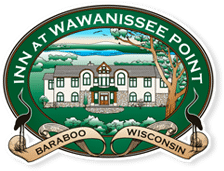April is a sweet time for birding in the Baraboo Hills with new arrivals almost daily. For new birders, the species returning then are easier to identify, and the unfurling leaves offer good treetop visibility and a subtle color palette that rivals fall. Flora and fauna are also bursting to life and romance abounds. April is an exhilarating time to rejuvenate on trails!
The Baraboo Hills Important Bird Area (IBA), in which Wawanissee Point and our 42 acres are nestled, is a sweet spot for birdwatching in Wisconsin. It’s one of the largest IBAs in the Midwest, according to the National Audubon Society. The contiguous, mixed hardwood forest here hosts at least 135 breeding bird species, some of which are important at-risk populations like the cerulean, worm-eating, hooded and yellow-throated warblers, white-eyed vireo and others.
Migration begins in late February to March when sandhill cranes are usually the first birds returning to the bluff. Their return is spring’s beginning for us. During March other hearty migrants—red-winged blackbirds, robins, song sparrows, killdeer, geese and turkey vultures—complete the first wave of spring migration.
April’s Wildlife Action
- Duck migration peaks the first week of April. Watch the bluffs’ upland marshes and ephemeral ponds, and sloughs around Lake Wisconsin.
- Ruffed grouse males begin drumming; listen along the forest-prairie ecotones.
- Bluebirds, great blue herons, Eastern phoebes, fox sparrows, Eastern towhees, house wrens, wood thrushes, tree swallows, catbirds, the brilliant scarlet tanagers and more return throughout April.
- In April at dusk male American woodcocks, also known as Timberdoodles, return to wet, brushy forest edges to perform their spectacular aerial courtship display, spiraling up to 300 feet high before zig-zagging in a downward dive. If you can’t see them you’ll hear their rhythmic, buzzy peents. Walk across from and near the Inn by the upland ponds to find them, besides at Devil’s Lake State Park’s Steinke Basin trails.
Spring is a frenzy by the end of April, for fauna, avifauna, and flora.
- The woodlands’ spring ephemerals are peeking from leaf litter.
- Waterfowl are hatching amid blooming marsh marigolds.
- Small mammals and deer are birthings.
- Frogs and toads are singing wildly for affection every night and sometimes during the day.
- We’re putting out jelly, oranges and sugar water, anticipating the ruby-throated hummingbirds and Baltimore Orioles any day.
Prepare For Birding, Hiking, And Stargazing
April daytime highs are in the 50s and low 60s by month’s end. Morning lows are at or above freezing. Frost fading from the soil leaves trails squishy. Bring your waterproof hiking boots. You’ll encounter wet spots along the woodland trails and lower spots. Dress in layers.
Bring warm base layers and blanket for dawn and dusk gazing. Snuggle by terrace fire with your coffee, wine or s’mores to …
- Watch daybreak and hear the birds’ dawn chorus
- Savor spring color and blooms in the warming sun
- Stargaze and drift through the spring peepers’ serenade
Use our…
- binoculars
- field guides
- Devil’s Lake State Park Bird Checklist
- trail maps
There are biking and paddling rentals locally for more ways to explore.
If it’s too cool or damp for you, stay in and use our binoculars in the south-facing sunroom to watch our feeders at the edge of the woods. From the Great Room skybox, you can zoom in over the greening prairie and beyond with our spotting scope.
Daybreak is an ideal time to see many birds. They’re aflutter refueling themselves after arriving in the night or slumbering. Slip into our enchanted forest when the first rays of light break to enjoy the birds’ dawn chorus mixing with flowing creek sounds in the moist air with earthy aromas.
Book a guest room HERE or call us at 608-355-9899.
Where To Bird Around The Inn
Our 42 acres of prairie and woods with three miles of groomed trails and …
- Adjacent to us Parfrey’s Glen State Natural Area with access to the Ice Age Trail west to Devil’s Lake State Park.
- Two miles from here the Riverland Conservancy’s 1,900 acres of forest, prairie, savanna, wetlands and streams laced with 12.7 miles of trails, including 3.2 miles of Ice Age Trail that connect to Devil’s Lake State Park. riverlandconservancy.org
- Devil’s Lake Oak Forest and South Bluff/Devil’s Nose State Natural Areas, within Devil’s Lake State Park, are considered one of state’s top 10 birding sites by the Wisconsin Society for Ornithology. For the nature reports from The Park visit its blog at www.devilslakewisconsin.com.
- 20 minutes northeast is Leopold-Pine Island Important Bird Area (IBA) 16,000 acres adjacent the Aldo Leopold Center along Levee Road, which is Rustic Road 49, and the Wisconsin River. Explore a 2.5-mile trail through 305 acres of oak savanna, wetlands and a dry prairie remnant overlooking the River, critical habitat for grassland birds and sandhill crane staging during migration. Around 40 bird species use this IBA during migration.
- Baxter’s Hollow State Natural Area, 30 minutes west of the Inn, offers great birding and spring blooms. It’s an extensive tract of deep forest with a gorge cut through the Baraboo quartzite by Otter Creek, a mountain-like stream. This is prime warbler habitat, attracting birds rarely seen elsewhere in the state, such as worm-eating and hooded warblers, and would be a good spot to look for the yellow-throated warbler. This preserve protected by The Nature Conservancy since the 1960s still seems wild and untouched. The challenging hike in will reward you, or walk along the abutting dead-end road. Watch the weather warming and insect activity to time your visit for warbler watching.
- Enjoy a 40-minute scenic drive west of here into the heart of Sauk County where the glaciated landscape meets the driftless for outstanding birding at Natural Bridge State Park and Natural Area, and Honey Creek, Pine Hollow and Hemlock Draw State Natural Areas (SNA). Owned by the Wisconsin Society for Ornithology and The Nature Conservancy, Honey Creek SNA has hosted as many as 180 bird species, besides 500 native plants. The SNAs don’t have groomed trails, often a primitive footpath and more challenging hiking, but the habitat and discoveries make it worthwhile. Take a map of the SNA and a compass.
Bird By Car
If you’re unable to hike more difficult terrain to see birds, drive Sauk County’s four Rustic Roads. Rustic Road 21—Slotty, Orchard, Schara and Ruff Roads—winds through four SNAs (see #7 above) and offers a lovely, slow drive through scenic working land and protected forests. Slightly east of RR 21 is Baxter’s Hollow State Natural Area, along the dead-end Stone Pocket Road, seven miles west of U.S. Highway 12 (see #6 above).
- It’s best to see the Leopold-Pine Island IBA while driving nine miles of RR 49, Levee Road, since most of this area is privately owned. (see #5 above).
- For more birding by-car-ideas near the Inn, see the late Harold Kruse’s article at The Nature Conservancy’s Web site and download his birding map.



